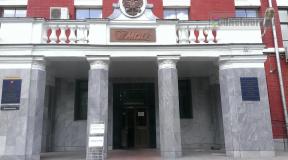National Statistical Committee of the Republic of Belarus (Belstat). Interstate Statistical Committee
17.01.2020
Statistics in the Republic of Belarus began to develop as part of the statistical system of the Russian Empire. Since the beginning of the 20th century, statistics departments operated in provincial cities, the main task of which was to conduct censuses.
In 1918, provincial statistical departments were renamed provincial statistical bureaus.
It should be noted that during the transition to socialism, the role of statistical bodies increased markedly, due to the construction of a centralized management system. If the statistical data of private enterprises were primarily of an informational nature for the state, then for the Soviet government this information was one of the foundations of centralized planning.
On August 23, 1920, a decision was made in the BSSR to form statistical bodies. In 1920, the Central Statistical Bureau was formed, endowed by the Revolutionary Military Councils with broad powers to collect the necessary information.
At a meeting of the Council of People's Commissars on January 23, 1921, the staffing table and cost estimates of the Central Statistical Bureau were approved. It consisted of the following sections:
- demographic - 17 employees;
- statistics of public education - 14;
- public health statistics - 8;
- labor and social security statistics - 12;
- agricultural statistics - 16;
- current agricultural statistics - 16;
- statistics of industrial production - 27;
- economic statistics - 17;
- forest statistics - 8;
- military statistics - 8;
- statistics of public utilities and management - 13;
- general management department - 28.
Total: 184 employees.
As the national economy of the BSSR developed, in 1924 the Central Statistical Bureau was transformed into the Central Statistical Office. It received the powers of a united People's Commissariat, and the head of the department received the right of an advisory vote in the Council of People's Commissars.
Since 1925, the “Statistical Yearbook of the BSSR” began to be published. To mark the tenth anniversary of the formation of the BSSR in 1929, a large-scale statistical study “The Belarusian SSR in Figures” was published.
With collectivization and the development of industry, the volume of work and the role of state statistics continued to increase.
In 1930, the functions of the Central Statistical Office of the BSSR were transferred to the State Planning Commission under the Council of People's Commissars of the BSSR.
The same process happened with county statistical offices.
The Chairman of the State Planning Commission received the decisive vote in the Council of People's Commissars.
In the post-war period, the work of state statistical bodies was resumed. Their development went in parallel with the restoration of the republic's economy.
The tasks facing statistics have become extremely complex; new forms of organization are required. In 1948, the Central Statistical Office was formed on the basis of the existing Central Statistical Office of the State Planning Committee.
Since 1957, the CSB began work on mechanization and automation of accounting. In 1967, the first computers “Minsk-22” appeared.
In the post-war period, the most significant statistical activities were population censuses. They took place as part of the All-Union censuses in 1959; 1979; 1989
The next population census took place in the Republic of Belarus as an independent state in 1999.
In 1994, the Ministry of Statistics and Analysis of the Republic of Belarus was created on the basis of the State Committee on Statistics and Analysis.
In 2008 it was renamed National Statistics Committee.
The formation of Belarus as an independent state is associated with the transformation of the statistical system in accordance with international standards. This work began in 1992 and continues to this day. The goals and principles of statistical accounting are changing. There is a transition from the balance sheet of the national economy to the system of national accounts; the main indicator of economic development is (GDP).
In addition to conducting censuses, collecting and processing statistical data of enterprises, a constant ongoing information collection.
At the moment, the period of the National Statistical Committee is as follows: tasks:
- development of official statistical methodology in accordance with international standards;
- conducting statistical activities in accordance with the principles of state statistics;
- providing official statistical information to society, the state and the international community.
To achieve its objectives, Belstat carries out the following: functions:
- for the organization of state statistical observations, the formation of a system of national accounts, the collection and processing of statistical information, develops and approves the official methodology of statistical activities;
- together with other government organizations conducting state statistics, develops and approves a strategy for its development;
- submits a program of statistical work for approval by the Council of Ministers;
- carries out preparation and conduct of centralized state statistical observations;
- develops, approves and gives instructions on filling out state statistical observation forms;
- provides users with free access to software for compiling electronic statistical documents, provides paper forms for centralized state statistics, and provides explanations for filling them out;
- organizes centralized state statistical observations and manages their implementation;
- takes measures to ensure the confidentiality of statistical data and their use in accordance with the purposes of state statistics;
- provides collected and processed statistical information to the governing bodies of the Republic of Belarus, distributes statistical information in the manner prescribed by law;
- provides users with equal access to statistical information and the system for its generation;
- in accordance with international agreements, exchanges statistical information with relevant organizations of other states and international bodies;
- maintains official statistics databases;
- participates in the development and supports the functioning of specialized systems for processing state statistics information;
- conducts mobilization preparations for the National Statistical Committee, controls the relevant work of its territorial bodies and subordinate organizations;
- performs other functions specified by law.
The specification of the functions of Belstat is formulated in the “Strategy for the development of state statistics of the Republic of Belarus for the period until 2017”.
The legal basis for the activities of the National Statistical Committee of the Republic of Belarus are: Law “On State Statistics” No. 345-Z dated November 28, 2004, Regulations on Belstat approved by Decree of the President of the Republic of Belarus No. 445 dated August 26, 2008.
The Order of the National Statistical Committee “On the maintenance of state statistics in 2015” specifies specific forms of statistical reporting, defines the persons who compose and receive them, and the deadlines for execution.
The structure of the leadership and distribution of responsibilities of the National Statistics Committee can be studied on the official website http://belstat.gov.by.
The functions of different departments differ in the specifics of the field of study, however, they fundamentally coincide in the methodology and ultimate goal of the work.
Territorial divisions of Belstat represented by the main statistical departments in the city of Minsk and each region. Regional departments have statistics departments in each district.
Each of the divisions has its own specific tasks and functions, but they can be represented as structural elements of the general tasks and functions of the state statistical system.
The activities of all departments and services of the statistical system are determined by a common methodology.
The methodology of the National Statistical Committee of the Republic of Belarus is set out in the “Methodology for the formation and calculation of statistical indicators” and “Instructions for organizing and conducting state statistical observations”.
Exist accounting methods:
- the system of national accounts, consisting of twelve sections covering, among other things, the non-observable part of the economy;
- statistics:
- industry;
- innovation;
- fuel and energy complex;
- investment and construction;
- labor;
- finance;
- Agriculture;
- environment;
- foreign trade;
- domestic trade;
- transport;
- communications;
- services;
- household surveys;
- small business;
- population.
Research in these areas is subject to appropriate regulations.
As can be seen from the above, the system of state statistics in the Republic of Belarus is a detailed structure for the collection, processing and dissemination of data relating to almost all quantifiable aspects of social life.
If you notice an error in the text, please highlight it and press Ctrl+Enter
Interstate Statistical Committee of the Commonwealth of Independent States
The Interstate Statistical Committee of the CIS was formed in 1992 in pursuance of the decision of the heads of government of the CIS member states of December 30, 1991.
He is accountable to the Council of Heads of Government of the CIS and the Council of Heads of Statistical Services of the Commonwealth Member States, which also includes the Chairman of the CIS Statistical Committee (ex officio). The Committee works closely with national statistical offices, the Economic Council, the Executive Committee and other Commonwealth bodies.
Coordinating the activities of national statistical services, including within the framework of international projects for the development of statistics in the CIS region, assisting countries in reforming state statistics based on international standards, organizing a wide exchange of statistical information and thereby maintaining a common information space on the territory of the Commonwealth - these are the main tasks Interstate Statistical Committee of the CIS.
Over the past years, a clearly functioning system has developed in the Commonwealth space, which ensures the formation of both statistical information harmonized between countries and the application of a unified methodology based on international recommendations and taking into account the regional specifics of individual countries. The necessary technological unity in work is maintained, including in the form of constant working contacts at the level of heads of departments and specialists of the CIS Statistical Committee and national statistical services. The CIS Statistical Committee has created a common statistical database (including dynamic data series since 1992), to which round-the-clock access is provided to a wide range of users.
In organizing all this work, an important role was played by the timely adoption of the model legislative act “On State Statistics”, which was prepared by the CIS Statistical Committee, discussed at the CIS Interparliamentary Assembly and recommended by it to the parliaments of the Commonwealth countries for the development of national laws on its basis. This document defines the basic principles, procedure for organizing state statistics and regulating legal relations related to the collection, synthesis, dissemination and storage of statistical information.
The information received from national statistical services, the results of its synthesis and analysis are used by the CIS Statistics Committee for economic analysis and preparation of publications: monthly, quarterly and annual reports, analytical reviews and notes on the socio-economic situation of the CIS countries, statistical collections and yearbooks and other publications sent leaders of the Commonwealth states, their economic services, interstate structures of the CIS, international organizations (UN, OECD, etc.), national statistical services.
The CIS Statistics Committee pays great attention to fulfilling the functions of the working body of the Council of Heads of Statistical Services, guided by the need to solve pressing professional and international future and current problems. As a result, in 2013-2015 alone, materials were prepared on more than 50 issues, which were considered at six meetings of the Council held during this period.
Based on the resolution of the UN General Assembly, which granted observer status to the Commonwealth of Independent States (A/RES/48/237, 30.03.1994), the CIS Statistics Committee participates in the work of the UN Statistical Commission, the UNECE Conference of European Statisticians and its Bureau, the Committee on Statistics ESCAP is a member of the Committee for the Coordination of Statistical Activities, which includes over forty international statistical organizations.
Possessing the status of an international statistical organization and the corresponding powers from the Council of Heads of Statistical Services of the Commonwealth countries, the CIS Statistics Committee has ample opportunities to support the interests of the national statistical services of the region in various international projects.
54th meeting of the Council of Heads of Statistical Services of the CIS Member States, October 2015, Dushanbe

47th meeting of the Council of Heads of Statistical Services of the CIS Member States, April 2012, Moscow

“Implementation of the System of National Accounts (SNA) 2008”, meeting of specialists from national statistical services of the CIS countries, April 2016, Minsk

International Economic Forum of the CIS Member States “25 years together, new formats of interaction”, March 2016, Moscow
“Seminar on organizing and conducting international comparisons of gross domestic product”, August 2010, Minsk

“Problems of measuring basic labor market indicators in population censuses and labor force surveys”, meeting of heads and specialists of national statistical services of the CIS countries, August 2015, Bishkek

Russian agro-industrial exhibition “Golden Autumn”, CIS Statistics Committee awarded a Participant Diploma, October 2014, Moscow

“Development of agricultural and rural statistics in the CIS region” regional project within the framework of the Global Strategy for improving this section of statistics, meeting of specialists from national statistical services of the CIS countries, February 2015, Budapest

“Development of labor statistics in the CIS region: problems and prospects for information exchange”, meeting of heads and specialists of national statistical services of the CIS countries, December 2014, Republic of Belarus, Minsk

Exhibition “20 years of the CIS: towards new horizons of partnership”, CIS Statistics Committee was awarded a Participant Diploma, July 2011, Moscow

Awarding the Chairman of the CIS Statistical Committee V.L. Sokolin with the Order of Honor, the order is presented by the Chairman of the Executive Committee - CIS Executive Secretary S.N. Lebedev, March 2010, Moscow

The office automation project started in 2007. In 2010, it was decided to expand the scope of the EDMS and launch two projects to automate document flow. The goal of the first project is to create an Automated Electronic Document Management System (ADMS) both for Belstat itself and for territorial statistical bodies: the main statistical departments of Brest, Vitebsk, Gomel, Grodno, Minsk and Mogilev regions, as well as the city of Minsk.
As part of the project, it is planned to create a unified information space in which users are given the opportunity to collaborate with all documents. At the same time, the Belstat ASED automates not only traditional office work functions, but also the substantive activities of the committee, as well as the performance of analytical and reference information work.
The new system ensures integration with the secure email system of government bodies Mailgov and the Unified Information System for monitoring the implementation of orders of the President of the Republic of Belarus.
The second project is aimed at creating the Belstat Database of Ready Documents (RDB). This will allow us to standardize and unify the processes of intradepartmental management of summary statistical information, as well as to comply with the principle of “one-time input of information and its repeated use.”
In November 2010 The National Statistical Committee of the Republic of Belarus put into trial operation a corporate automated electronic document management system (ACED Belstat), built on the platform of the DELO system of the Electronic Office Systems company.It is expected that Belstat's ASED will unite with a single operating technology all statistical bodies connected to the system at the republican, regional and district levels and ensure compliance with the principle of “one-time input of information and repeated use”.
The main goals of creating the Belstat automated control system are:
- increase in the efficiency of the activities of structural divisions due to the optimization of technological processes for processing and movement of documents;
- increasing the quality level of employees’ work with electronic and paper documents;
- reducing the time required to perform various operations with documents (registration, search, transfer, etc.);
- maintaining end-to-end control over the execution of documents;
- reduction of deadlines for document execution;
- increasing the performance discipline of employees;
- a gradual decrease in the share of paper documents and an increase in the share of electronic documents in the general document flow.
In June - October 2010 The following commissioning work was carried out to put Belstat's automated control system into operation:
- installation and configuration at the workstations of users of the client part of the automated control system;
- adaptation of automated control system software (templates and reporting forms for obtaining statistical data according to specified criteria)
- training of personnel of the National Statistical Committee of the Republic of Belarus.
There are more than 350 people who use the Belstat automated control system.
The use of Belstat's automated control system has already at this stage ensured:
- creation and maintenance of a technological base of standard document processing processes (the structure of the base reflects the information model of the organization's management system);
- automated registration, placement of documents and information in a single database;
- unified tools for creating, editing and processing documents;
- control over the execution of documents and management decisions;
- standardization of electronic document formats within the system;
- integration with the secure e-mail system of government bodies “Mailgov”, the Unified Information System for monitoring the implementation of instructions of the President of the Republic of Belarus;
- typing of user workstations;
- generation of output documents and reports;
- protection of documents and information from unauthorized access based on a password system and user hierarchy;
- controlled movement of documents and cards via e-mail;
- access to information and multi-user work with documents over a local network.




















